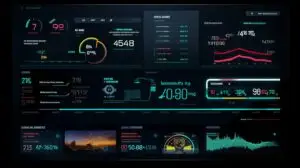Are you having trouble tracking the effectiveness of digital lead sources in your automotive BDC? Utilize tracking tools, apply special URLs and phone numbers, analyze data, and adjust lead generation strategies to allocate resources and budget more effectively.
To get the most out of your digital lead sources, embrace tracking tools. These will help you observe which sources are delivering the most leads, as well as provide insights into why certain sources may be more successful than others. You can then use this data to make informed decisions about where to allocate resources and budget.
Unique URLs and phone numbers can also be used to track lead sources. By creating distinct URLs and phone numbers for each lead source, you can easily track the source of each lead and determine which sources are most effective.
You should analyze the data you have collected to identify trends and patterns. This will help you make informed decisions about the best ways to generate leads and allocate resources.
You should adjust your lead generation strategies based on the data you have collected. By making small adjustments, you can maximize the effectiveness of your lead generation efforts and optimize your BDC’s performance.
By taking these steps, you can effectively track the effectiveness of your digital lead sources and revolutionize your BDC’s performance. Stop relying on guesswork and start utilizing data-driven strategies for success.
Key Takeaways
Successful digital lead source tracking in automotive BDCs involves utilizing tracking tools and software, implementing unique tracking URLs and phone numbers, and analyzing data to adjust lead generation strategies. This enables you to allocate resources and budget more efficiently, which will result in improved conversion rates and successful lead generation efforts.
The automotive industry is a highly competitive space, so it’s essential to monitor and modify strategies regularly to remain competitive and adjust to changing market conditions.
Importance of Lead Source Tracking in Automotive BDCs

Lead source tracking is crucial for automotive Business Development Centers (BDCs). It helps optimize marketing efforts and boost sales by revealing which campaigns generate the most leads. BDCs can focus on these effective channels, using resources efficiently. Without lead source tracking, BDCs spend money on marketing tactics without knowing which ones attract customers.
This tracking also provides insights into customer behavior. BDCs can analyze data to identify sources bringing in high-quality leads likely to convert into sales. This information helps customize marketing messages for specific audiences, making campaigns more effective. Understanding lead sources enables BDCs to create targeted marketing strategies appealing to their customers.
Utilizing tracking tools and software enhances these insights. These tools offer detailed analytics, allowing BDCs to follow the customer journey from lead generation to sale. By using these tools, BDCs can identify hidden patterns and trends, making informed decisions to improve overall marketing performance. Lead source tracking, combined with advanced tools, empowers automotive BDCs to succeed in marketing and sales.
Utilize Tracking Tools and Software

Take advantage of tracking tools and software to monitor and optimize your online marketing endeavors. These tools can provide valuable insights and data to help you make informed decisions on your lead generation strategies. Utilizing tracking tools and software is essential in the automotive BDC industry for the following reasons:
- Get a better understanding of your audience: Tracking tools can give demographic details, enabling you to customize your marketing campaigns to specific customer groups.
- Measure the efficacy of your marketing channels: By tracking the origins of your leads, you can find out which marketing channels are producing the most conversions and allocate your budget accordingly.
- Spot areas for improvement: Tracking tools can pinpoint underperforming campaigns or landing pages, giving you the opportunity to make necessary changes and enhance your lead generation process.
- Track the customer journey: With tracking tools, you can follow the whole customer journey, from the initial lead capture to the final sale, allowing you to identify any bottlenecks or areas of improvement.
- Make data-driven decisions: By analyzing the data from tracking tools, you can make data-driven decisions and fine-tune your online marketing strategies to maximize your ROI.
By using unique tracking URLs and phone numbers, you can further improve your lead source tracking capabilities and gain even more valuable insights into your online marketing efforts.
Implement Unique Tracking URLs and Phone Numbers

By implementing tailored tracking URLs and phone numbers, you can gain valuable insights into your online marketing strategies, allowing you to optimize campaigns and maximize your return on investment.
Tailored tracking URLs are web addresses that are specifically designed for each marketing campaign or source. When a potential lead clicks on one of these URLs, they are directed to your website, and the system monitors their activity, providing precise information about their behavior, such as the pages they visit and the actions they take. This data can help you understand which campaigns are generating the most traffic and conversions, enabling you to allocate resources more wisely.
You can measure the success of different marketing channels with unique tracking phone numbers. Each phone number is connected to a specific source, allowing you to track incoming calls and gather data on which sources are driving the most leads. With this intel, you can make informed decisions about where to devote your marketing budget and put your efforts into the highest-converting sources.
By deploying tailored tracking URLs and phone numbers, you can collect comprehensive data on the performance of your online marketing initiatives. This data serves as a foundation for the next step: analyzing the data and pinpointing high-converting sources.
Analyze Data and Identify High-Converting Sources

To optimize your online marketing strategies and maximize your return on investment, analyzing collected data from tailored tracking URLs and phone numbers is essential. This allows you to gain important insights into which sources generate the most leads and conversions for your automotive BDC.
Through the data, you can discover which campaigns, websites, or advertising channels are driving the most traffic and bringing in the highest number of qualified leads. Studying the data can also help you recognize patterns and trends in consumer behavior. The data can reveal the demographics, interests, or behaviors of your highest converting customers. This information can then be used to refine your marketing strategies and target your messaging to attract more of these valuable leads.
Analyzing the data and identifying high-converting sources enable you to make data-driven decisions and use your resources and budget smartly. This ensures that you are investing in the channels that are delivering the best results.
Allocate Resources and Budget Based on Data

Maximize the effectiveness of your marketing strategies by allocating resources and budget based on the valuable insights gained from analyzing data. After pinpointing the high-converting lead sources, it is essential to use your resources wisely. Investing more in the sources that yield the highest conversion rates will help you optimize your budget and improve your chances of acquiring quality leads.
Begin by giving a larger portion of your budget to the top-performing lead sources. These sources have proven to be the best return on investment, so allocating more resources to them is a smart move. This way, you can be sure that you are taking full advantage of converting leads and meeting your sales goals.
Some sources could have potential but may not be doing as well as expected. In such cases, you can give a smaller part of your budget to these sources and watch their performance closely.
By allocating resources and budgets based on data-driven insights, you can make educated decisions and refine your lead generation strategies. This will help you keep track of and adjust your strategies in order to get the best possible results, ultimately maximizing your lead generation efforts and boosting sales.
Continuously Monitor and Adjust Lead Generation Strategies

To stay on top of the ever-changing digital landscape, it’s important to analyze data regularly and identify patterns and trends. This will help you understand which sources are driving the most leads and which are not performing as well. Reallocating resources and budgets to focus on more effective channels is key.
Keeping an eye on the competition is also important, as they may be targeting specific audiences with new lead generation approaches. Evaluate if these strategies align with your own goals and make adjustments accordingly.
It’s essential to stay agile and monitor lead generation strategies continuously. Collect feedback from your team and customers, and be willing to make changes when necessary. This will help optimize your lead generation efforts and increase the chances of success in the automotive BDC industry.
Conclusion – Digital Lead Source
Successful digital lead source tracking in automotive BDCs requires utilizing tracking tools and software. It also involves implementing unique tracking URLs and phone numbers. Analyzing data and adjusting lead generation strategies is crucial. By doing these things, you can allocate resources and budget more effectively. This will ultimately lead to higher conversion rates and successful lead generation efforts.
In the fierce automotive industry, it’s vital to monitor and modify strategies continuously. This will help you stay competitive and adapt to changing market conditions.
Frequently Asked Questions
What is the role of digital lead source tracking in the automotive industry?
It helps dealerships find out which sources are generating the most leads, allowing them to use their resources as efficiently as possible.
By keeping track of where the leads are coming from – such as online ads, social media, or email campaigns – dealerships can understand which advertising strategies are most efficient. With this information, they can adjust their campaigns to improve sales.
How can tracking tools and software benefit automotive BDCs?
They provide invaluable insights into the efficacy of different lead sources, allowing you to maximize your marketing efforts.
With these tools, you can track and analyze data on leads and conversions with ease, helping you make wise decisions to refine your lead generation techniques.
What are unique tracking URLs and phone numbers, and how do they contribute to lead source tracking?
Tracking URLs and phone numbers is a must for accurate lead source tracking in automotive BDCs. These tools help assign leads to specific sources, such as online ads or social media campaigns.
With unique URLs, you can monitor which websites are generating the most leads. One-of-a-kind phone numbers also allow you to trace back calls to the source.
This data can be used to adjust your marketing strategies and make the best use of your resources to maximize lead generation and conversions.
What types of data should be analyzed to identify high-converting lead sources?
To identify high-converting lead sources, you should analyze a variety of data. Begin by looking at the quantity of leads produced from each source and their conversion rates. Assess the quality of leads by measuring the percentage of leads that result in sales. Compare the cost per lead to the return on investment.
Think about factors such as the length of time to convert leads from each source and any customer reviews or feedback. Good SEO standards should also be taken into account.
How can the data from lead source tracking be used to allocate resources and budget effectively in automotive BDCs?
To effectively allocate resources and budget in automotive BDCs, lead source tracking data can be used. Analyzing this data can help you determine which lead sources are giving the highest conversion rates.
You can then focus your resources on these sources that are more likely to lead to sales. You can also adjust your budget accordingly, allocating more funds to the most successful lead sources and reducing the amount spent on those that are less productive.

Zach White is a dynamic and insightful writer specializing in the field of digital sign systems and technology. With a keen eye for the latest trends in digital signage and a deep understanding of the technology that powers them, Zach has made a significant impact in the industry through his engaging and informative content.
His journey began with a fascination for the intersection of technology and visual communication. This passion led him to pursue a degree in Communication Technology, where he honed his skills in both technical understanding and effective communication.
Zach’s articles and blogs, known for their clarity and depth, have helped demystify complex digital signage technologies for a wide audience. His work not only covers the technical aspects but also delves into the creative possibilities of digital signs, offering valuable insights for both industry professionals and enthusiasts.
As a writer for a leading digital signage company, Zach plays a crucial role in educating and inspiring his readers about the potential of digital sign systems in transforming public spaces, advertising, and information dissemination. His ability to explain intricate technical details in an accessible manner has made him a sought-after voice in the field.
In addition to his writing, Zach is an active participant in industry conferences and seminars, where he shares his knowledge and stays abreast of emerging technologies. His commitment to staying at the forefront of digital signage innovations ensures that his readers always get the most current and relevant information.
Zach’s contributions to the field have not only earned him respect among his peers but have also made a tangible difference in how digital sign systems are perceived and utilized in the modern world.





